
ARM vs. DSP vs. FPGA: Main differences between them
Global electronic component supplier AMPHEO PTY LTD: Rich inventory for one-stop shopping. Inquire easily, and receive fast, customized solutions and quotes.
What is the ARM?
ARM (Advanced RISC Machines) is a well-known company in the microprocessor industry, designing a large number of high-performance, inexpensive, low-power consumption RISC processors, related technologies, and software. ARM architecture is the first RISC microprocessor designed for the low-budget market and is the industry standard for 32-bit microcontrollers, which provides a series of cores, system extensions, microprocessors, and system-on-chip solutions, with four functional modules available for manufacturers to configure production according to the requirements of different users. Since all products use a common software architecture, the same software can run in all products. ARM currently holds more than 90% share in the handheld device market, which can effectively shorten the time of application development and testing, and also reduce the R&D cost. ARM is a 32-bit microcontroller with high performance of internal hardware resources, which can be loaded with an operating system to become its main feature, with an operating system, it can multitask in real time like a PC, that is, it can complete multiple tasks at the same time tasks at the same time, and will not affect each other.
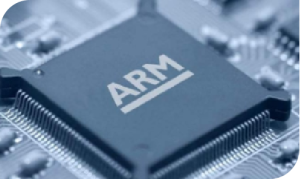
ARM Architecture
Reduced instruction set computing (RISC) architectures for computer processors include the Arm architecture family. With more than 250 billion Arm-based chips supplied by our partners over the past three decades in products ranging from sensors, wearables, and smartphones to supercomputers, it is the most widely used processor architecture in the world. Integrated security, high performance, and energy efficiency, a sizable ecosystem for worldwide support, and pervasiveness across markets and locales are all advantages of the Arm CPU design.
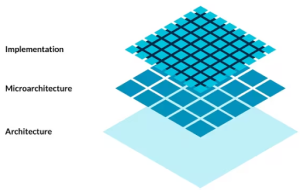
What is the FPGA?
FPGA, a type of semi-custom circuit in the field of Application Specific Integrated Circuit (ASIC), addresses the lack of custom circuits and gets over the drawback of the original programmable devices' constrained number of gates. It is not overstated to suggest that FPGAs can implement FPGAs as a piece of paper or a collection of building blocks and can carry out the operations of any digital device, from high-performance CPUs to basic 74 circuits. Software simulation allows us to check the design's accuracy in advance. Using the online modification feature of the FPGA, it is also feasible to change the design at any moment after the PCB is finished without altering the hardware circuit. FPGAs can significantly reduce design time, PCB space, and system reliability when used to create digital circuits. Programming the on-chip RAM is necessary for FPGA operation because operational states are set by programs stored in on-chip RAM. Different programming techniques can be used by users depending on the setup mode.
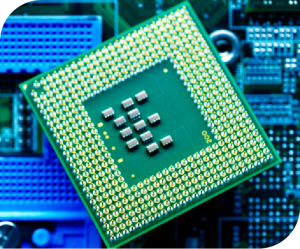
FPGA Architecture
An elementary FPGA design is made up of tens of thousands of essential components known as configurable logic blocks (CLBs), which are connected to one another by a network of programmable interconnects known as a fabric. The interface between the FPGA and external devices is made up of input/output (I/O) blocks. The CLB may alternatively be referred to as a logic block (LB), a logic element (LE), or a logic cell (LC), depending on the manufacturer. Multiple logic blocks make comprise a single CLB. An FPGA's lookup table (LUT) is one of its distinguishing characteristics. For any combination of inputs, a LUT holds a preset list of logic outputs; LUTs with four to six input bits are common. Multiplexers (mux), full adders (FAs), and flip-flops are examples of common logic operations. The more advanced CLBs found in current-generation FPGAs can do many operations with only one block, and they can be combined to perform more intricate tasks like multipliers, registers, counters, and even digital signal processing (DSP) operations.
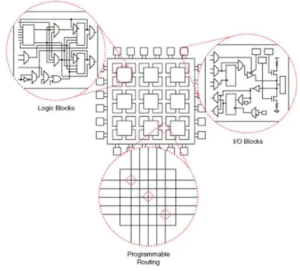
How does FPGA work?
The FPGA chip reads data from the EPROM into the on-chip programming RAM when the power is connected, and once the configuration is complete, the FPGA enters the working state. The FPGA can be used frequently because it only needs a general-purpose EPROM or PROM programmer, not a specific FPGA programmer. There is only one EPROM that needs to be changed when the FPGA function needs to be altered. The same FPGA can provide many circuit functions in this manner by using different programming information. FPGAs can therefore be used in a variety of ways. One of the greatest options for small volume systems to increase system integration and durability is FPGA chips, it may be mentioned.
What is the DSP?
Digital signal processors (DSPs) are special microprocessors that process a lot of data using digital signals. They have their own full set of instructions. Its most crucial characteristic is that it features a Harvard bus structure and a dedicated internal hardware multiplier to handle a lot of digital information quickly. A digital signal processor on a small chip includes a control unit, a processing unit, a variety of registers, and a number of storage units, among other things. Its periphery can also be connected to a number of memories and can communicate with a number of external devices. The Harvard design used by the DSP allows for complete overlap between fetching and executing instructions since the data bus and address bus are split, allowing the program and data to be stored in two different locations. As a result, the microprocessor may execute the previous instruction and fetch and decode the following instruction simultaneously, considerably accelerating processing performance. Due to the device's enhanced versatility, it also permits data and program transmission. It functions by taking in analog signals, converting them to digital signals of 0 or 1, then augmenting, removing, and changing the digital signals. Finally, other system chips decode the digital data back into analog data or the true environmental format.
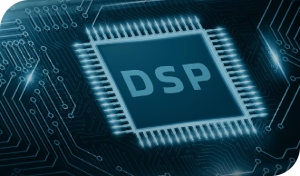
DSP Architecture
The following diagram represents DSP's super Harvard architecture. SHARC DSP, which is a shorthand for Super Harvard Architecture, is the moniker Analog Devices gave to their new ADSP-211xx and ADSP-2106x families of DSPs to describe how they work inside. Some features were added to this architecture in order to boost throughput. While the super Harvard architecture digital signal processors are optimized in a number of ways, an instruction cache and an I/O controller are important enough to be included.
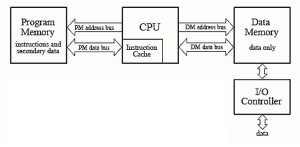
ARM vs. DSP vs. FPGA Features
ARM Features
- Load/store architecture
- Integrated security
- Orthogonal instruction set
- Single-cycle execution
- Energy efficiency
- 64- and 32-bit execution states
- Hardware virtualization support
DSP Features
- One multiplication and one addition can be completed in one instruction cycle.
- Separate program and data spaces, allowing simultaneous access to instructions and data.
- Has fast RAM on-chip, which can usually be accessed simultaneously in two blocks via separate data buses.
- Hardware support for low or no overhead loops and jumps.
- Fast interrupt handling and hardware I/O support.
- Multiple hardware address generators that operate in a single cycle.
- The ability to execute multiple operations in parallel.
- Support for pipelined operation, so that operations such as fetching, decoding, and execution can be executed overlappingly.
FPGA Features
- Configurable logic blocks
- Programmable interconnects
- Programmable routing
- Programmable I/O blocks
- On-chip memory
- Digital Signal Processing (DSP) blocks
- System-level interconnect
- Designing ASICs using FPGAs
ARM vs. DSP vs. FPGA: Advantages and Disadvantages
Advantages and Disadvantages of ARM
Advantages of ARM
- Load-store architecture: To minimize memory interactions, the processor uses a load-store architecture that stores data in various registers. To move data from external memory to the register bank, it has distinct load and store instructions. Low Power Consumption: AMP Processors use less energy. Initially, they were intended to operate at lower power. Even so, their architecture uses fewer transistors. They also have additional characteristics that make this possible.
- Work More Quickly: ARM only does one operation at once. This speeds up its operation. It features a speedier response time and decreased latency.
- ARM processors are built with a multiprocessing feature that allows them to be used in systems that employ many processors to process data.
- Affordable to create – ARM Processor is very affordable as it does not need expensive equipment for its creation. When compared to other processors, it is created at a much lesser price.
Disadvantages of ARM
- It cannot be used in Windows since it is incompatible with X86.
- Some processors have speed limitations, which could be problematic.
- When using ARM processors, scheduling instructions might be challenging.
- The programmer must execute instructions correctly. This is because the execution of them determines the total performance of ARM processors.
- Programmers with extreme skills are required for ARM processors. This is due to the significance and complexity of execution (a processor performs worse when improperly performed).
- Limited performance: ARM processors may not have the same processing capability as other processor types, which may affect their capacity to execute more demanding programs.
- Compatibility: Some software may not be compatible with ARM processors, which can limit the range of applications that can be run on ARM-based devices.
Advantages and Disadvantages of DSP
Advantages of DSP
- For real-time program implementation, DSP uses high-level programming languages like C or assembly.
- Quick software upgrades made possible by the use of DSP devices greatly improve the system's dependability, adaptability, replaceability, and flexibility.
- Software adaptability.
- Suitable for conditional operations, especially difficult multi-algorithm applications.
Disadvantages of DSP
- The serial instruction stream has restrictions.
- Only calculations that are exceedingly simple can be performed on the data by a DSP at sampling rates larger than a few MHZ.
- The long cycle of development.
Advantages and Disadvantages of FPGA
Advantages of FPGA
- High integration, rapid processing, and effective execution on a large scale.
- FPGA allows for the completion of challenging sequential logic designs, and programming is flexible, useful, simple, and repeatable.
- Programming can be done again and endlessly on a large number of FPGAs. Reconfiguration can reduce hardware overhead.
- The vast bulk of the flip-flops and logic gates on the chip are look-up table structures.
- Most of the implementation is done using SRAM.
Disadvantages of FPGA
- The initial logic setting is frequently lost during a power interruption.
- Timing is challenging to plan.
- It cannot manage many events.
- It is not suitable for use under the circumstances.
ARM vs. DSP vs. FPGA
|
ARM |
DSP |
FPGA |
|
| Characteristics | 1. The Arm architecture lays forth a set of guidelines that direct how the hardware behaves when a specific instruction is carried out. 2. It is an agreement between the hardware and the software that specifies how they will cooperate. | Computer hardware that is rigid and underpowered. To improve the system's performance capabilities, the number of DSPs must be increased. | Thanks to adaptable hardware, built-in memory, and embedded CPUs, it is a functioning system with scalable computing capability. |
| Programming language | A low-level programming language is an assembly language. The actual binary opcode that the core actually executes has a one-to-one relationship with the assembly language instructions (mnemonics). | DSP programming is done in C, an assembly language. | The majority of FPGAs employ HDL, a hybrid digital and analog description language that includes VHDL, Verilog, and Verilog-AMS. |
| Cost | High-performance, low-cost, low-power RISC processors | In contrast to general DSPs, which are very affordable, application-specific DSPs are expensive. The cost of reconfiguring a DSP is also high. | Various applications can be made to function with FPGAs through modification. Due to their adaptability, they are easy to use. |
| Applications | Consumer electronics like smartphones, tablets, wearables, and other mobile devices frequently employ Arm processors. Additionally, they are utilized in a variety of sensors and IoT devices. | Systems with low sampling rates, low data rates, multi-condition operation, processing complex multi-arithmetic workloads, using C programming, and utilizing floating points are all suitable for DSP. It is also suitable for systems that operate under several conditions. | The usage of fixed-point computing, block diagram programming, large data rates, and systems with quick sampling rates (a few MHZ) are all viable uses of FPAG. |
Conclusion of ARM vs. DSP vs. FPGA
ARM is now divided into 32-bit and 64-bit two, its internal hardware resources of high performance, can be loaded with an operating system has become its main feature, with the operating system, it can be like a PC multi-tasking real-time processing, is the same time to complete multiple tasks, and will not crash. ARM has relatively strong transaction management functions, can be used to run interfaces and applications, etc., and its advantages are primarily visible in the control. Neither will be impacted by the other. DSP is mostly utilized for computing tasks like modulation and demodulation, encryption and decryption, etc. The strong data processing capacity and quick operation speed are advantages. Due to their flexibility and capacity for programming, debugging, reprogramming, and repeating processes, FPGAs enable complete design development and verification. The benefits of FPGAs are best shown when there are minor circuit modifications, and their ability to be programmed in the field can extend the shelf life of the product in the market and be used for system upgrades or debugging. DSP is a general-purpose signal processor, which implements data processing with software; FPGA implements data processing with hardware. DSP has low cost, flexible algorithm, and strong functionality, while FPGA has a good real-time and higher cost, FPGA is suitable for engineering use with simple control function algorithms and contains a lot of repeated calculations, and DSP is suitable for engineering applications with complex control function and contains a lot of calculation tasks. DSP uses software to implement algorithms, whereas FPGA uses hardware. As a result, the processing speed of FPGA will be higher. Another significant factor explaining why FPGA is faster than DSP is that it can perform parallel computing, whereas DSP primarily uses software to extract instructions for execution, which is still serial execution.
Related Articles
- ·What is ARM microprocessor? What is the difference between an ARM processor and a normal processor?
- ·How to Generate Low Clock Frequencies in FPGA?
- ·How to Use DDR Memory with FPGA for DSP Application?
- ·Application of Embedded Systems in Aerospace and Defense Fields
- ·Comparison of FPGA, ARM, STM32, and DSP Platforms
- ·Comparison of FPGA, CPLD, PLC, Microprocessor, Microcontroller & DSP
- ·What is the difference between SoC, FPGA, and ASIC?
- ·The composition, functions, advantages, and disadvantages of FPGA
- ·Understand the differences between CPU, GPU, IPU, NPU, TPU, LPU, MCU, MPU, SOC, DSP, FPGA, ASIC, GPP, and ECU
- ·FPGA vs MCU: What is the difference between them?When to use them?
